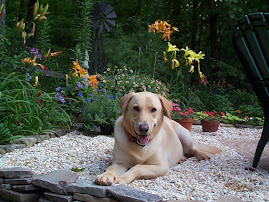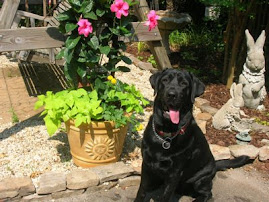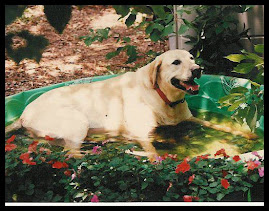Many of you know that I have been deeply troubled over the deaths of 6 dogs in this year's Iditarod. When Maynard, from Warren Palfrey's team died, it became even more personally painful as I had spent time with Kate and their great team of dogs.
This year's weather was brutal, with blinding blizzards and windchill temperatures dipping into the 50 below range. The conditions were exceptional and took its toll on many mushers and dogs.
Mushers Kim Darst and Blake Matray decided that Mother Nature's force was too wicked. They made the difficult decision to request assistance, but not to save themselves.
This story renewed my faith...

Iditarod mushers recall storm-bound ordeal
By Tim Mowry
Published Sunday, March 29, 2009
FAIRBANKS — A dead dog wasn’t worth the belt buckle and finisher’s patch that Blake Matray would have received had he completed the 1,150-mile Iditarod Trail Sled Dog Race, a dream that ended in a storm about halfway through the race from Willow to Nome.
Back home in Two Rivers a week after he pulled out of the historic mushing race, Matray is content knowing that he helped save the life of a dog in fellow musher Kim Darst’s team during a storm that brought the two mushers literally to their knees on one of the most wild sections of the trail.
“It’s disappointing I’m not going to have a belt buckle and (finisher’s) patch, but that dog survived and I’ll hang my hat on that every day,” Matray said of an 8-year-old dog named Cotton that was in Darst’s team. “I did right by a fellow musher I was traveling with, and if I had to do it all over again I’d do the same thing.”
Matray’s dream of finishing the Iditarod ended about 8 p.m. on March 16 when he, Darst and their 26 dogs were flown off the trail by the Iditarod Air Force after being caught in a storm that left them wallowing in waist-deep snow on a drifted-in trail between Iditarod and Shageluk, about 600 miles into the race.
Just 16 hours earlier, things were going well for Matray and Darst. Even though they were the last two mushers on the trail, Matray and Darst still were plugging along, which is precisely what Matray planned to do with his team of mostly Siberian huskies, which are known for their endurance more than their speed.
The two mushers, both pilots, had forged a friendship on the trail and their teams were traveling at comparable speeds. Matray had 14 healthy dogs in his team and Darst was driving a team of 13 strong dogs when they pulled out of the Iditarod checkpoint for the 67-mile run to Shageluk at 1:40 a.m.
Halted by storm
Despite reports of a hard-packed and fast trail, Matray and Darst ran into trouble almost immediately after leaving the ghost town that serves as the race’s halfway point.
“We didn’t go two miles out of the checkpoint and the winds picked up to 25 mph,” Matray said. “The trail was already drifted over. We started breaking trail almost immediately.”
The two mushers spent the next six hours breaking trail through soft, drifted snow. The trail was hard to discern, and every time their dogs veered off it, the mushers had to wade through waist-deep snow.
“It was like wading through a swimming pool to get up to them,” Matray said.
Eventually, they resorted to crawling up to the front of their teams on their hands and knees because it was easier than floundering in the snow, Matray said.
After six hours, they decided to camp to rest their dogs and see if the weather improved. They put jackets on their dogs and dug holes in the snow to serve as snow caves for the dogs to get them out of the wind, which Matray estimated was blowing at least 35 mph. Combined with the 10 below temperatures, the wind chill probably was pushing 50 below, he said.
Matray also was carrying enough straw to give each pair of his 14 dogs a small bed. The two mushers fed their dogs dry food on the snow because it was impossible to melt snow for water or use food bowls because of the wind.
They then crawled into a tent that Matray was carrying and tried to sleep. When they awoke at 1 p.m., 5 1/2 hours after they stopped, the wind still was blowing and the dogs were covered by snow. The mushers dug out the dogs to check on them, and Darst found one of her dogs, an 8-year-old leader named Cotton, in trouble.
“She came running back and said, ‘Blake, I’ve got a dog that’s freezing to death,’” Matray said.
The dog’s eyes were rolling back in its head and it was convulsing, he said.
Recognizing that the dog was hypothermic, Matray told Darst to put the dog in her sleeping bag and climb in with the dog to warm it while he checked the rest of the dogs. Matray also fired up his Jet-Boil, a small gas stove used to heat water, to warm the tent. Once Cotton was in the sleeping bag, she stopped shaking.
At that point, the two mushers had a decision to make: Keep the dog in the sleeping bag, load it into Darst’s sled and keep breaking trail toward Shageluk, or push a button on the Spot Device, a handheld satellite and safety messenger that Darst was carrying, to call for help.
Tough decision
Both mushers knew that if Darst pushed the button their race likely would be over. Iditarod rules forbid mushers from receiving outside assistance.
But they also knew that breaking trail another 45 miles to Shageluk would take at least another day of hard travel. They didn’t know if Cotton would make it that long.
“We were physically fine, but that dog was hurting,” Matray said.
So Darst pushed the button, which sent a message to her mother in Anchorage. Her mother notified race officials.
“At that point, we knew our race was over, but we saved the dog,” Darst said. “We wound up deciding (Cotton’s) life was more important than the race.”
At 3 p.m., an Iditarod Air Force plane flew over but didn’t land. Unbeknownst to Matray and Darst, another rookie musher, Lou Packer, was having problems a few miles up the trail and Iditarod pilots were checking on him. Packer had been caught in the same storm that stopped Matray and Darst. Two dogs in his team died. Had he known Packer was in trouble ahead of them, Matray said he would have walked up to check on him.
Four hours later, two men on snowmachines from the village of Shageluk arrived to check on Matray and Darst. They told the mushers about Packer’s problems and said an airplane was flying out to pick he and his team up.
“We told them we had a hypothermic dog and we needed to get it out of there,” Matray said.
They loaded the dog and Darst into a sled one of the men was towing and raced up the trail to get Cotton on the plane.
When the two men returned with Darst, they asked the two mushers what they wanted to do. At first, Matray and Darst thought about continuing, but the men told them the trail to Shageluk was “obliterated.” Figuring they already were disqualified from the race after calling for help and getting assistance from the two men on snowmachines, Matray and Darst decided to pull out of the race and have their dogs flown off the trail rather than mush to Shageluk on bad trail.
Following behind the two men on snowmachines, the mushers found a sheltered place to camp for the night. The snowmachiners cut down several trees with a chain saw so the mushers could build a fire, then returned to Shageluk to inform race officials of their decision to scratch and their request for air support.
Driving their teams to Shageluk didn’t make any sense at that point, Matray and Darst said.
“There was no need for us to run the dogs to Shageluk when we were disqualified anyway,” she said. “That was better for the dogs.”
Cotton lives
Early the next day, four Iditarod Air Force planes arrived and flew the two mushers and their dogs to Unalakleet, where Darst was reunited with Cotton.
“They had her on top of a chest freezer with an IV in her,” Darst said of her 8-year-old leader. “When she saw me, her tail was going ‘thump, thump thump.’”
The sight of Cotton wagging her tail was enough to show Matray that the mushers made the right decision in calling for help and getting her flown off the trail.
“When I went into that hangar and that dog was standing there wagging its tail, that made it all worth it,” he said. “The vets told me that if we had continued on that dog would probably have been dead by the time we got to Shageluk. They worked on her for four hours.”
Veterinarians told Darst that Cotton’s body temperature was in the low 80s when she arrived in Unalakleet. The average body temperature of a healthy dog is 101 degrees. Vets pumped warm saline solution into her with IVs and used heated blankets to get her temperature back up.
“The vet said that dog was 10 minutes from dying when they got her to Unalakleet,” Darst said.
Though she was a rookie from New Jersey, Darst, a 40-year-old helicopter pilot, was a capable musher, Matray said. She never panicked in the storm.
“She kept her head,” he said. “She did what she needed to do to take care of herself and her dogs.”
At the same time, Darst said she “couldn’t have asked for a better running partner” than Matray, a 41-year-old pilot for the Alaska Air National Guard.
Both Matray and Darst think they would have been able to finish the race had it not been for Cotton’s troubles.
“I had 14 healthy dogs out of Iditarod,” Matray said. “I felt like we had the ability to reach Nome, but everything changed when that dog was sitting in that tent dying.”
Said Darst, “I think it would have been tough, but we would have done it. I think we would have gotten there, but it would have taken a long time.”
Positive outlook
Part of the reason Matray wanted to tell his feel-good story is to counter the bad publicity the Iditarod received for the fact that six dogs died in this year’s race.
He returned home to read headlines about animal cruelty in the race and the fact that People for the Ethical Treatment of Animals, the animal-rights group that has hounded the Iditarod for years, wanted criminal charges filed against mushers with dead dogs.
What he and Darst did shows how much mushers care for their dogs, Matray said.
“Two mushers did all they could to save a dog once it was in doubt, to the point of leaving the race to make sure it got the medical attention it needed,” he said.
Race officials didn’t necessarily show the same loyalty to Matray and Darst, however.
When the two mushers showed up in Unalakleet after being flown off the trail, not a single race official talked to them about their ordeal or about scratching from the race.
“They never even came up to us when came to Unalakleet,” Darst said. “We never signed any paperwork or anything.
“They never said, ‘Nice decision with the dog,’” she said. “They just ignored us.”
But the experience didn’t sour her on mushing. Darst, who was driving back to New Jersey with her dogs when contacted for this story, said she plans to run the Iditarod again in the future to fulfill her dream of completing the Last Great Race.
As for Cotton, she’s doing fine.
“I call her my belt buckle now,” Darst said. “I could have had a dead dog or a belt buckle, and I chose the dog.”
For Matray, this was his second and last attempt at the Iditarod. He started the race in 2003 when the start was moved to Fairbanks, but he ended up scratching 300 miles into the race when his dogs fell sick.
He and his wife, Erin, have family plans, and Matray doesn’t envision having the time that’s required to prepare an Iditarod team.
“This was my last shot,” he said.
But Matray is a glass-half-full kind of guy. He’d rather focus on the upsides rather than downsides of a situation. He’s already thinking about putting on a clinic for novice mushers about how to handle storms on the trail.
“There is no formal forum to pass on that kind of knowledge,” he said.
His ordeal on the Iditarod Trail simply reinforced to him what the race is all about, Matray said.
“There was weather the race hadn’t seen in years,” he said. “The stuff we encountered was a reminder that it’s the Iditarod and it’s Alaska and sometimes the weather on the trail can be dire and can blow up in a moment’s notice.”
Contact staff writer Tim Mowry at 459-7587.

Blake at this year's Musher's Meeting
Visit Blakes's website and leave a comment on his guestbook:
http://teambdo.homestead.com/

I got this picture of Kim's truck in the parking lot of The Millennium.
 Another great story about Kim:
Another great story about Kim:
 You're right, Deb-Picasa is easy and fun. Even a dummy like me can make a collage.
You're right, Deb-Picasa is easy and fun. Even a dummy like me can make a collage.  You're right, Deb-Picasa is easy and fun. Even a dummy like me can make a collage.
You're right, Deb-Picasa is easy and fun. Even a dummy like me can make a collage. 


 He will retrieve the ball but doesn't always bring it right back, as he would prefer to be left alone to rip the ball apart. He isn't nearly into the retrieving part as Sas.
He will retrieve the ball but doesn't always bring it right back, as he would prefer to be left alone to rip the ball apart. He isn't nearly into the retrieving part as Sas.
 He has no desire to play with others, including me!
He has no desire to play with others, including me!

 Another great story about Kim:
Another great story about Kim:



 Since I was staying at the Millennium, I was able to visit with some of the dropped dogs Monday and Tuesday morning before my departure.
Since I was staying at the Millennium, I was able to visit with some of the dropped dogs Monday and Tuesday morning before my departure. 


 Most of these dropped dogs were suffering from minor ailments such as sore shoulders or hips.
Most of these dropped dogs were suffering from minor ailments such as sore shoulders or hips. All the dogs were sweet, affectionate and appreciative of the extra attention.
All the dogs were sweet, affectionate and appreciative of the extra attention. 


 Tim Hunt
Tim Hunt






.jpg)

.jpg)





























